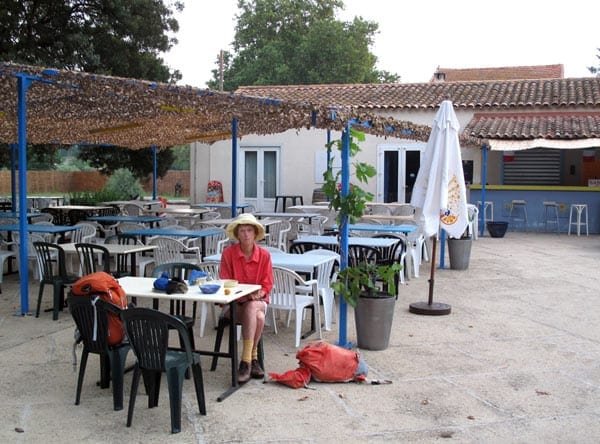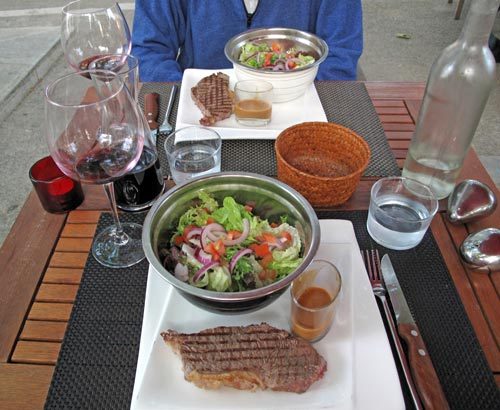Wednesday, 4 July 2012
Distance 22 km
Duration 4 hours 35 minutes
Ascent 33 m, descent 31 m
Map 170 of the TOP 100 lime-green series

There was none of the festive air of the night before as we ate our muesli at the deserted bar, but we felt good after a night’s rest and were looking forward to our new itinerary, cruising from one village café to the next all the way to Montpellier.
We left at 6:40 am, continuing along the road that we had arrived on, and came almost immediately to the highway.
At the corner was a house whose occupant, an old woman, accosted us and asked where we were going. “Compostelle”, I replied untruthfully, to save explanations – everybody in France has heard of that.
She was impressed and lamented the fact that she and her husband had never done the pilgrimage. They no longer had their youth, she said, and when they did have it, they had no time.

It was an easy few kilometres along the highway to Aimargues, passing a roundabout at the exit to le Cailar and then a second one. The traffic was light except for one moment when a large, slow farm vehicle – a tractor or harvester – held up a long line of cars.
The countryside was flat and verdant, with fine trees scattered about. Once in the centre of Aimargues, the hoped-for bar appeared, although we did not see it as first because of all the road works.

In fact there were two but we chose the one on the corner near the fountain, which had some tables in the shade. It was a real treat to have coffee so early in the day.
As we sat there drinking, a plump, pretty girl in high heels tripped by towards the bus stop. A minute later she came running back and disappeared into a house, from which she presently burst forth and hurried past again, flustered and disarrayed. We felt for her, poor girl. I think she managed to catch the bus.

From Aimargues our next destination was Marsillargues and there was an ideal little road that threaded its way across the fields and delivered us to the bridge over the Vidourle. Just beyond this was the village.
The main street was divided by a line of beautiful mature plane trees that arched their branches over the road and made a wide green tunnel. We saw several cafés but did not stop, as we were still fuelled by the previous coffee and wanted to stop again in Lunel, which was not far away.
Our effort to find the small road to Lunel took us in a circle. Various people told us various things but we knew we were wrong when we arrived at the highway, the D34.

The road we wanted was the D34E, and luckily we asked a man clipping his hedge, who actually knew where it was.
It was a narrow, patched, flat, empty strip of bitumen, just right for walkers, but having finally located it, we quickly found it curving round and rejoining the highway that we had been at such pains to keep off. Immediately after that we crossed a much bigger road and entered the streets of Lunel.
It took us much longer that we expected to penetrate to the centre. Cars were being directed on a one-way circuit around the old town and we tramped three-quarters of the way round before seeing signs to the Office of Tourism.
Even so we had to ask twice before we found it, tucked away near the church, in a tree-shaded street that had been largely blocked to cars.

The woman attendant gave us a map of Lunel and another one of Montpellier, but said there was no list of all the accommodation in the department (we were now in Hérault).
On the map she indicated the way to a small road out of town, the D189, that would take us to Lansargues. We had coffee, with pastries, under the plane trees a few doors further on. It was a hot, sunny day, but pleasant in the shade.

When we set off again, we must have misunderstood our instructions (probably turning off the ring road too soon), because we never came to the turn-off to the D189, no matter how far we walked. By the time we arrived at the hamlet of St-Just and knew we were wrong, but it was too late to turn back.
The road that we were on (the D24) was quite busy and became a bit hazardous after this, because there was no verge at all, just a steep bank beside the bitumen, and cars were forced to wait their turn to get past us, which they did with remarkably good grace.
We hurried along for three or four kilometres like this, through fields of melons and vines, and eventually came to a sign,”Lansargues Commerces”, pointing down to the right, and another, “Camping 2 km” pointing straight ahead. Not knowing what to do, we opted for the commerces, as we were thirsty and tired.

This turned out to be the right thing, as the descending street soon opened into a wide square, where lunch diners crowded the tables under the trees.
Before settling down in this lovely place for a drink, we visited the épicerie, three minutes before it closed at 12:30, and bought some sausage and a tomato in case dinner was not forthcoming. We asked where the camping ground was the woman said it was a “petit kilometre” further on.
Then we went to the brasserie, which was doing brisk lunch trade, and enquired about dinner – they would not be serving meals tonight but the other restaurant in the square would.
Having taken all these necessary precautions, we sank into red chairs under a red umbrella and indulged in large cold beers, a happy moment. The local paper, which we borrowed from the bar, had a weather forecast for tomorrow promising storms, but it did not look likely.

Walking to the camping ground was a simple matter of taking the small road out of town past the brasserie at the bottom of the square, which had evidently been the old main road before the present highway was put in to bypass the village.
This was confirmed by an old sign on the wall : CD189, the very road we had been searching for since we left Lunel. It was no distance at all on this before we saw a row of mobile homes through the fence and rounded a corner to the entrance of the camping ground.
This was rather a superior establishment, with a pool and a terrace shaded by a large palm-thatched conical roof (palm fronds seem to be the material of choice for umbrellas and shades in these parts). It also had a snack bar with a TV.
We were shown to a pleasant little nook under some pine trees, which had a soft carpet of needles instead of grass, and plenty of shade.

For lunch we reclined on our sleeping mats and had a salad of tomato, cucumber, onion and lettuce dressed with mayonnaise removed from last night’s table, a piece of steak left over from the same meal and fresh bread from Lunel.
Showers, clothes-washing and a sleep occupied the afternoon until we strolled to the snack bar for a coffee and to watch the last of that day’s stage of the Tour. Then we had a fortifying glass of rosé and set off to explore the village.

The old part was at the bottom, a warren of lanes clustered around the church, which had strange curved buttresses and a dear little pepper-pot tower stuck on at the back.
There seemed to be a lot of young families in residence – probably it is close enough to Montpellier to allow for commuting.
For dinner we sat in the same red chairs in the square that we had occupied when we arrived. Both the chairs and the wooden table were as heavy as lead, obviously top quality, and very different from the usual stackable plastic ones favoured by French eateries.

The place was quite full and we were glad that we got a table outside. We ordered two courses for €15.
While waiting we noticed two teenage girls hanging about – identical twins, one in pink and the other in sea-green. Every time our young waiter came out, he pressed his lips onto those of the pink twin as he went past.
If they swapped shirts while he was inside there would be trouble, probably.

Dinner was excellent. Keith started with a salad of Bayonne ham and melon and I had a beautiful celeriac and crab rémoulade.
Then we both had the succulent steak known as faux filet, with pepper sauce and a salad served separately.

The wine and the bread disappeared with their customary speed and we were at peace with the world.
When we paid the bill the waiter said that they had only been open for three weeks, which made us feel very lucky.
Previous day: St-Gilles to Vauvert